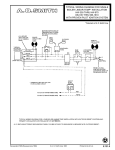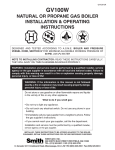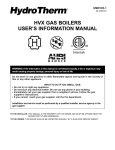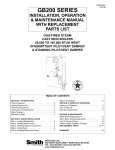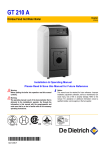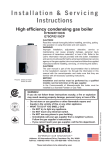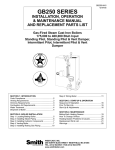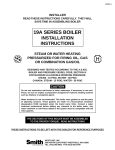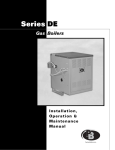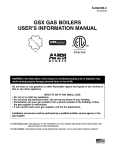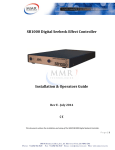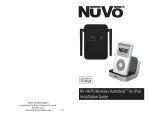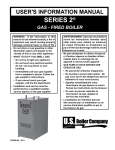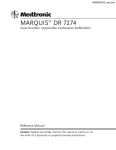Download GVXUM-1
Transcript
GVXUM-1 00-GVXUM GVX GAS BOILERS USER’S INFORMATION MANUAL WARNING: If the information in this manual is not followed exactly, a fire or explosion may result causing property damage, personal injury or loss of life. Do not store or use gasoline or other flammable vapors and liquids in the vicinity of this or any other appliance. WHAT TO DO IF YOU SMELL GAS: • Do not try to light any appliance. • Do not touch any electrical switch. Do not use any phone in your building. • Immediately call your gas supplier from a neighbor’s phone. Follow the gas supplier’s instructions. • If you cannot reach your gas supplier, call the fire department. Installation and service must be performed by a qualified installer, service agency or the gas supplier. TO THE INSTALLER: THIS MANUAL IS THE PROPERTY OF THE OWNER AND MUST BE AFFIXED NEAR THE BOILER FOR FUTURE REFERENCE. TO THE OWNER: THIS BOILER SHOULD BE INSPECTED ANNUALLY BY A QUALIFIED SERVICE AGENCY. PAGE 2 HVX USER’S INFORMATION MANUAL BASIC OPERATION WARNING Service on this boiler should be undertaken only by trained and skilled personnel from a qualified service agency. CAUTION Should overheating to shut off, do not electrical supply to the gas supply at appliance. occur or the gas supply fail turn off or disconnect the the pump. Instead, shut off a location external to the Do not use this boiler if any part has been under water. Immediately call a qualified service agency to inspect the boiler and to replace any part of the control system and any gas control which has been under water. A. General. This water boiler is an induced draft appliance and is equipped with controls for proper operation. All controls must be in proper working order. Contact a qualified service agency to provide annual maintenance as specified in Installation, Operation and Maintenance Manual. 1. Limit. See Figure 1. A device which automatically interrupts boiler operation when the water temperature exceeds the set point. Maximum allowable temperature is 220°F (104°C). Original equipment with this boiler is a Honeywell L4080B1253. Boiler operation is interrupted when system temperature reaches cut-out temperature. Boiler operation resumes automatically when system temperature falls approximately 15°F (8°C) below the cut-out temperature. 2. Flame Rollout Switch. See Figure 1. A device which automatically interrupts boiler operation when flames or excessive heat are present in the combustion area. The control is a single use device. If the control is activated to interrupt boiler operation, do not attempt to place boiler in operation. Contact a qualified service agency. 3. Pressure Switch. See Figure 1. A device which automatically interrupts boiler operation when there is excessive blockage in the vent system or fan motor does not operate. This control is an automatic reset device. If control is activated to interrupt boiler operation, do not attempt to place boiler in operation. Contact a qualified service agency. 4. Pilot. The pilot provides the ignition source for the main burners. Your boiler has an intermittent pilot. The intermittent pilot ignites only when there is a call for heat and extinguishes when the call for heat ends. See Figure 5. 5. Gas Valve. The gas valve monitors pilot flame and regulates gas flow to the burners and pilot. See Figure 1. 6. Safety Relief Valve. A device which protects the boiler against excessive pressure. The safety relief valve can discharge a large amount of hot water - the installer should provide piping to discharge water near floor at a floor drain. See Figures 2 and 3. If the safety relief valve discharges water, follow instructions TO TURN OFF GAS TO APPLIANCE (see Figure 4), and contact a qualified service agency. B. Instructions to place boiler in operation and to turn off the boiler are shown on the Operating Instruction Label posted on the inner jacket panel of the boiler. The instructions are also shown in Figure 4. C. Sequence of Operation. 1. Thermostat calls for heat, energizes circulator. 2. Limit senses boiler water temperature. Prevents operation until water temperature falls approximately 15°F (8°C) below the cut-out temperature. 3. Fan energizes. 4. Gas valve energizes. a. Igniter on. b. Pilot gas on, igniting pilot. 5. Pilot flame detected. a. Igniter off. b. Main gas on, igniting main burners. Note: If pilot flame is not detected within 30 seconds, the igniter is turned off for 30 seconds, and then turned back on. If the pilot is not detected within 30 seconds, the igniter and pilot gas are turned off for 5 minutes. The sequence then resumes at Step 4a. 6. Call for heat ends. Pilot and main gas off, extinguishing pilot and main burners. If this sequence is not followed exactly, follow instructions TO TURN OFF GAS TO APPLIANCE (see Figure 4) and contact a qualified service agency. HVX USER’S INFORMATION MANUAL Figure 1: Control Locations Figure 2: Safety Relief Valve Hook-Up Installation with Air Elimination in System Piping Figure 3: Safety Relief Valve Hook-Up with Air Elimination PAGE 3 PAGE 4 HVX USER’S INFORMATION MANUAL Figure 4: Intermittent Ignition Operating Instructions HVX USER’S INFORMATION MANUAL PAGE 5 USER MAINTENANCE WARNING Product Safety Information Refractory Ceramic Fiber Product This appliance contains materials made from refractory ceramic fibers (RCF). Airborne RCF, when inhaled, have been classified by the International Agency for Research on Cancer (IARC), as a possible carcinogen to humans. After the RCF materials have been exposed to temperatures above 1800°F (980°C), they can change into crystalline silica, which has been classified by the IARC as carcinogenic to humans. If particles become airborne during service or repair, inhalation of these particles may be hazardous to your health. Avoid Breathing Fiber Particulates and Dust Suppliers of RCF recommend the following precautions be taken when handling these materials: Precautionary Measures: Provide adequate ventilation. Wear a NIOSH/MSHA approved respirator. Wear long sleeved, loose fitting clothing and gloves to prevent skin contact. Wear eye goggles. Minimize airborne dust prior to handling and removal by water misting the material and avoiding unnecessary disturbance of materials. Wash work clothes separately from others. Rinse washer thoroughly after use. Discard RCF materials by sealing in an airtight plastic bag. First Aid Procedures: Inhalation: If breathing difficulty or irritation occurs, move to a location with fresh clean air. Seek immediate medical attention if symptoms persist. Skin Contact: Wash affected area gently with a mild soap and warm water. Seek immediate medical attention if irritation persists. Eye Contact: Flush eyes with water for 15 minutes while holding eyelids apart. Do not rub eyes. Seek immediate medical attention if irritation persists. Ingestion: Drink 1 to 2 glasses of water. Do not induce vomiting. Seek immediate medical attention. WARNING Service on this boiler should be undertaken only by trained and skilled personnel from a qualified service agency. Inspections should be performed at intervals specified in the Installation, Operation and Maintenance Manual and this User’s Information Manual. Maintain manuals in a legible condition. Keep boiler area clear and free of combustible materials, gasoline and other flammable vapors and liquids. Do not place any obstructions in boiler room that will hinder flow of combustion and ventilation air. A. General Housekeeping (Continuous). 1. Keep boiler area clear and free of combustible materials and obstructions to the free flow of combustion and ventilation air to the boiler. 2. Do not store or use gasoline or other flammable vapors or liquids in the vicinity of the boiler or any other appliance. 3. Do not store or use sources of hydrocarbons in the vicinity of the boiler. Sources of hydrocarbons include bleaches, cleaners, chemicals, sprays, paint removers, fabric softeners and refrigerants. 4. Check Safety Relief Valve for water leakage. If leakage exists, contact a qualified service agency. B. Inspect Vent System (Monthly): Vent pipe must be sealed with no separations, obstructions, or sags. CAUTION Vent system operates under positive pressure when venting horizontally or vertically with 3" diameter AL294C vent. Leakage in vent system will spill products of combustion into building. Severe vent system leakage can cause carbon monoxide poisoning. PAGE 6 HVX USER’S INFORMATION MANUAL C. Inspect Pilot and Main Burner Flames (Monthly). 1. Remove Front Jacket Panel by lifting and pulling out. 2. Adjust thermostat to lowest setting. 3. Loosen screws at Burner Observation Cover, located on base, just above main burners and remove cover by lifting. CAUTION Burner Observation Cover may be hot! 4. Adjust thermostat to highest setting. Verify operation follows Section C, Sequence of Operation, of this manual. 5. View flames through observation port. 6. Check pilot flame. See Figure 5. The pilot flame should be medium blue covering approximately ³⁄₈" to ¹⁄₂" (10 to 12 mm) of the sensing probe. If the flame is yellow and lazy, follow instructions TO TURN OFF GAS TO APPLIANCE (see Figure 4), and contact qualified service agency. 7. Check main burner flames. See Figure 5. The flames should have clearly defined inner cones approximately 1½" (40 mm) high and should have a very sharp blue color characteristic. If the flame is yellow and lazy, follow instructions TO TURN OFF GAS TO APPLIANCE (see Figure 4), and contact qualified service agency. 8. Adjust all thermostats to lowest setting to shut down boiler. 9. Replace Burner Observation Cover and Front Jacket Panel. 10. Adjust thermostats to normal setting. D. Controls (as required by control manufacturer)1. 1. Safety Relief Valve. Conduct try lever test as outlined in manufacturer’s instruction tag on the safety relief valve. 2. Low Water Cut-off (if used). Follow instructions provided by control manufacturer. E. General Inspection and Maintenance (Annual). For continued safe operation a qualified service agency must provide a more detailed inspection of burners, heat exchanger and vent system, and provide maintenance as specified in the Installation, Operation and Maintenance Manual. Figure 5: Pilot and Main Burner and Flames Controls maintenance may be part of annual inspection and maintenance by a qualified service agency if annual frequency is xspecified by controls manufacturer. 1 HVX USER’S INFORMATION MANUAL PAGE 7 WESTCAST, INC. 260 NORTH ELM STREET • WESTFIELD, MA 01085 TEL. (413) 562-9631 FAX (413) 562-3799 www.smithboiler.com








